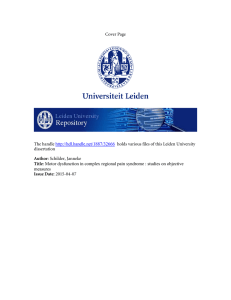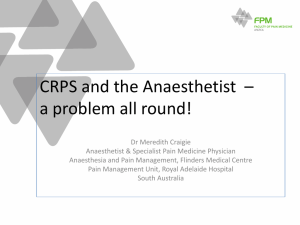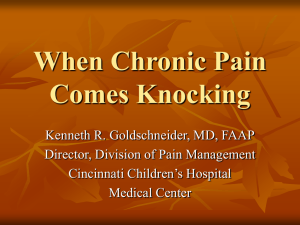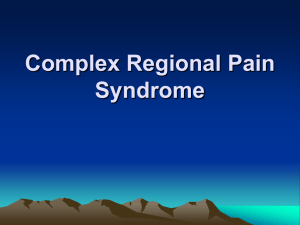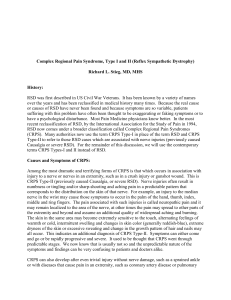Advice from people living with Complex Regional Pain Syndrome
advertisement
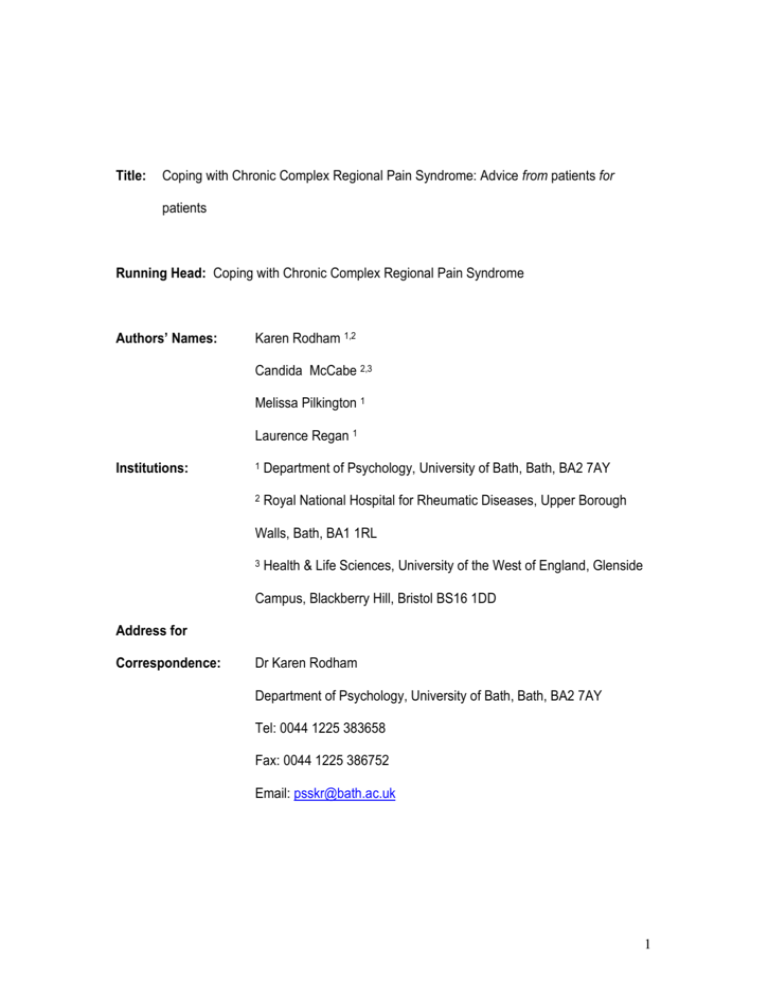
Title: Coping with Chronic Complex Regional Pain Syndrome: Advice from patients for patients Running Head: Coping with Chronic Complex Regional Pain Syndrome Authors’ Names: Karen Rodham 1,2 Candida McCabe 2,3 Melissa Pilkington 1 Laurence Regan 1 Institutions: 1 Department of Psychology, University of Bath, Bath, BA2 7AY 2 Royal National Hospital for Rheumatic Diseases, Upper Borough Walls, Bath, BA1 1RL 3 Health & Life Sciences, University of the West of England, Glenside Campus, Blackberry Hill, Bristol BS16 1DD Address for Correspondence: Dr Karen Rodham Department of Psychology, University of Bath, Bath, BA2 7AY Tel: 0044 1225 383658 Fax: 0044 1225 386752 Email: psskr@bath.ac.uk 1 Coping with Chronic Complex Regional Pain Syndrome: Advice from patients for patients Abstract Objective: To explore what advice people currently living with chronic CRPS would offer to another person coming to terms with a diagnosis of chronic CRPS. Methods: Semi-structured interviews with 21 adults (5 male) living with chronic CRPS who had completed a CRPS rehabilitation programme were conducted. Results: Effectively self-managing CRPS required individuals to play an active role. This could only be achieved if they felt they had sufficient control. Means of attaining control involved attaining a level of acceptance, becoming well-informed and accessing the right kind of support. The advice offered by patients for patients largely reflected that offered by healthcare professionals. One area where there was a conflict concerned sleep hygiene. Conclusions: Our study provides support both for the argument put forward by Redman1 that without appropriate preparation and support, self-management is ineffective, and that by Skuladottir and Halldorsdottir2 that the main challenge of the chronic pain trajectory is that of retaining a sense of control. The clinical implications of this are discussed. Key Words: Complex Regional Pain Syndrome, Self-Management, Thematic Analysis, 2 Coping with Chronic Complex Regional Pain Syndrome: Advice from patients for patients Rodham, K., McCabe, C., Pilkington, M. & Regan, L. Introduction Complex Regional Pain Syndrome (CRPS) usually occurs after a precipitating event or trauma, but may occur spontaneously.3-6 It has an incidence of 5.46-26.2 per 100,000 person years.7 Burning pain is the most characteristic symptom of CRPS; other symptoms include swelling, coldness, colour changes, hypersensitivity, increased sweat and hair growth, and motor changes. Symptoms are usually experienced in a single limb, though CRPS may occur in multiple limbs and other body regions4, 8-11. CRPS is something which the majority of patients experience as a transient problem. However, there are a significant minority of patients (approximately 15-20%), who will develop chronic CRPS, with some continuing to demonstrate disability at more than 10 years post onset.12,13 For those patients whose symptoms do not spontaneously resolve within the first year, long term residual symptoms or impairment are common. For example, CRPS pain is often invisible and is difficult to explain to family, friends and colleagues. In addition, patients are faced with the frustration of no longer being able to do the things they used to and can lose their sense of identity.14 Furthermore, Bruehl15 notes that fear of pain can be worse than the pain itself and 3 writes of the ‘dramatic disuse” that can develop in an effort to avoid experiencing a feared increase in pain. Reduction in the use of one’s limb can reduce the active range of motion in the affected limb, which can lead to increases in sensitivity to pain. This in turn can lead to social avoidance, whereby patients avoid leaving their homes for fear of being accidentally bumped by those around them. Early diagnosis and prompt treatment are considered best practice to reduce the risk of longterm physical and psychological complications arising from lack of use of a limb and living with chronic pain.16 Treatment is palliative rather than curative and so focuses on improving function. CRPS can be both distressing and debilitating and have a considerable impact on the lives of both the person with CRPS and those closest to them.17 Once diagnosed, a combination of physiotherapy, occupational therapy, desensitisation and psychological therapy are recommended.4,16,18-19 Unfortunately the process of diagnosing CRPS is not straightforward, due in part to the lack of specific tests or biomarkers,4 and so can be characterised by scepticism on the part of the clinician and confusion for the patient.20 Given that the healthcare system struggles “to cope with the demands of acute care, let alone the needs of those with long term health conditions”,21 it is essential that those living with chronic conditions are able to self-manage. However, Redman1 suggests that there is “little or no prospect of achieving the intended outcome” because many patients whose chronic 4 diseases could be managed by patient self-management, are not prepared for, or supported to take on this role. Successful self-management necessitates the development of a range of skills including knowledge of the condition and its treatment, maintenance of adequate psychological functioning and the ability to implement lifestyle changes required when living with a chronic condition.1, 22 One means of developing this skills set is via the completion of a rehabilitation programme. The act of completing a rehabilitation programme has been shown to increase participants’ positivity, feelings of being understood and also validates their CRPS experience.23 Furthermore, patients completing such programmes report perceiving that they were beginning to take back some control over their condition and, by association, their lives.23 The feeling of regaining control is an important element of successful self-management of chronic conditions. Retaining or regaining a sense of control is also central to the theory proposed by Skuladottir and Halldorsdottir2 to explain how women cope with chronic pain. They suggest that maintaining a sense of control both of the self and of the pain is key to coping, but they also highlight the way in which this sense of control can be dependent on the quality of encounters with health professionals. Good quality encounters are seen as empowering and as facilitating control and conversely poor quality encounters are disempowering and mark a loss of a sense of control. Furthermore, researchers focusing on other conditions have also noted that attempts to gain a sense of control over chronic illness and disability can have a positive impact on 5 patients adherence, in terms of following health professional’s treatment and self-management recommendations.24-26 However, evidence suggests that regimens requiring long-term changes to behaviour (such as exercise and desensitisation of the affected limb(s) often two or three times a day, as well as learning to pace activities) tend to have poorer adherence.27 Specific barriers to adherence include lack of an ability to fit into one’s routine,24,28 the belief that the changes are too time consuming and boring,29 lack of appropriate expertise amongst healthcare professionals23 and conflicting perspectives of patients and providers.30 Similar issues arise with carers who lack understanding and knowledge and struggle to provide support 31. Other researchers have also noted that without support, the motivation to engage with rehabilitation exercises is likely to wane.24, 28, 32 Given the problems associated with adhering to rehabilitation advice, conflict in terms of patient and provider understanding of management of conditions, and obstacles preventing patients from becoming self-managing, the aim was to invite people living with chronic CRPS to share what advice they would give to someone else coming to terms with chronic CRPS. It was anticipated that accessing the advice from patients for patients would provide an insight into the process of becoming self-managing. 6 Method As part of a larger study, a semi-structured interview schedule was developed to explore the lived experiences of people with CRPS. The interview schedule consisted of questions in four specific areas: how CRPS started, the impact of CRPS, which coping strategies have worked/not worked and finally what self-management advice participants would offer to someone else who has chronic CRPS. Interviews were conducted by KR (CRPS Health Psychologist). In this paper, we report solely on the fourth area of the interview; the advice our participants would offer to someone living with chronic CRPS. Participants: Adult participants were recruited who had previously completed a CRPS inpatient rehabilitation programme at a national specialist centre and were considered to have chronic CRPS (>6 months). As part of the larger study mentioned above, this cohort of patients (n=94) received postal questionnaires to gather information about coping with CRPS. At the end of the questionnaire participants were invited to indicate their willingness to be interviewed about their experiences. Of 46 participants who completed the questionnaire, 21 (5 male, 16 female) people aged between 22 to 65 years expressed an interest in being interviewed. They had been living with CRPS for between one and eleven years. Demographic details of the participants can be found in Table 1. Those who agreed to be interviewed were contacted and a convenient date and location for the interview was arranged. The interviews were conducted either face-to-face or over the telephone, depending on the participants’ preference. All 7 interviews were recorded, transcribed and analysed verbatim. Novel issues raised in earlier interviews were incorporated into later interviews. Participants chose their own pseudonyms to maintain anonymity. Table 1: demographic data ABOUT HERE Ethical Approval: Ethical approval for the research was granted by a local National Research Ethics Service (NRES) board and the University of Bath Psychology Department ethics board. Data Analysis: The fourth area of the interview schedule was simply focused on gaining insight into the advice our participants would offer to someone living with chronic CRPS. Our aim therefore, was to provide a thematic description of the data. As such we took an inductive approach whereby the data was analysed without trying to fit it into a pre-existing coding. Coding continued until saturation was reached; in other words until there were no new insights or themes identified in the transcripts.33 We followed the five steps of Thematic Analysis as outlined by Braun and Clarke:34 1) Familiarising self with the data: reading and re-reading the transcripts highlighting ideas for coding/themes. 2) Generating initial codes: organising the data into meaningful groups. The data set is worked through systematically and attention paid specifically to data items that might form the basis of repeated patterns (themes) across the data set. 8 3) Searching for themes: sorting the different codes into potential themes and collating all the relevant coded extracts within the identified themes. Relationships between codes, between themes and between different levels of themes are identified. 4) Reviewing themes: ensures that data within themes coheres together meaningfully and that the distinctions between themes are clear. 5) Defining and naming themes: identifying the ‘essence’ of what each theme is about and determining clearly what aspect of the data each theme captures. The transcripts were initially coded by a member of the research team (KR) but in order to reduce researcher bias and optimise the trustworthiness of the analysis, a sample of interview transcripts were independently coded by two further members of the team (LR and MP). The three researchers then reviewed their analyses and agreed on themes. No substantial differences were found during the comparison. The final themes were chosen on the basis of the richness, universality and salience of the theme in the transcripts, rather than based on prevalence of the theme alone. Results The core overarching theme concerned the emphasis on the person living with CRPS playing an active role and taking control over the situation (see Figure 1). In terms of recommendations made by participants as to how those coming to terms with living with chronic CRPS might 9 begin to take back control, three key areas were identified: ‘Acceptance’, ‘Gaining the right support’ and ‘Becoming informed’. FIGURE 1 ABOUT HERE Theme 1: Acceptance: Acceptance was presented as something desirable but extremely difficult to attain. Acceptance was described as something you worked towards without a definite end-point due to the unpredictability of CRPS. It was nonetheless considered to be an important marker of the process of (re)gaining control. Participants explained that until a level of acceptance had been attained they felt they were at the mercy of CRPS which if left unchecked could rule one’s life: ‘Cos some people I think, get to the stage where CRPS rules their life, and that is, they get up and they just live CRPS for the rest of their lives’ (Hope) Acceptance involved both practical and emotional elements of the chronic illness experience. Participants were clear that a major step on the journey to acceptance involved recognising and coming to terms with the fact that there is no cure for chronic CRPS. One participant (Cloggy) stated very plainly that her key piece of advice to another person would be to ‘Accept the fact that this [CRPS] is what it is’. For Cloggy, coming to terms with the diagnosis was really important because it enabled her to engage in a fair fight: ‘I could put a name to something, and then you can fight it’. Searching for a name for their symptoms was something which was 10 commonly mentioned by participants. For example, Grace spoke about how distracting this search could be: ‘I would say don’t be sidetracked into thinking it’s something else’. Indeed, without the diagnosis and a level of acceptance it was impossible to work towards an ability to self-manage, because participants were essentially battling the unknown. This was an impossible situation for it was not feasible to effectively arm oneself without knowing what weapons were required. It was unsurprising that the participants felt ill-equipped for such a battle and were exhausted by fighting against fugacious possibilities. Indeed, many spoke about the energy that they had expended on seeking a wide variety of different treatments in the hope that each one would cure their CRPS: “Get to the point where you stop looking for a cure and don’t let it run your life” (Hope) Another commonly articulated experience concerned conflicting expectations. At the start of their journey towards acceptance participants had felt that they were expected to hide how they were really feeling from their loved ones as illustrated by Stella: ‘People don’t want you being always miserable in front of them. My husband had enough to cope with me having it, let alone [me] being a sort of, a bit down you know’ (Stella) Conversely others spoke of feeling that they were expected to go into great detail about their condition in order to explain (and justify) what CRPS was, as illustrated by Bill’s quote: 11 ‘I suppose the first thing I would say to them is try not to constantly explain to people what you have got. When people say to you in general “how are you?”, just say “I’m fine thanks, how are you” (Bill) There was a clear sense of the drain that these conflicting expectations had had on participants. This sense of duty to report or hide their feelings was something that receded as they progressed on their journey to acceptance. This journey enabled them to see that acceptance included accepting negative as well as positive emotions rather than suppressing them. Marks of reaching acceptance were the recognition that feeling sad was just as valid an emotion as being positive and the ability to be honest with themselves and those around them: ‘Allow yourself to cry and don’t be afraid to cry with others, you know, with your, with your close circle of friends [pause ] I think at times I’ve shed enough tears for half the world’ (Juliette) It was also clear that participants had become aware that the expectations they put upon themselves were often unrealistic and overly demanding. Acceptance was therefore also concerned with being kind to yourself and recognising when your own expectations might be making things harder than they need to be. It was common for participants to express the view that they had at times made things more difficult for themselves as a consequence of expecting 12 change to occur at a fast pace. The importance of recognising that it takes time to come to terms with chronic CRPS was a key recommendation participants wished to pass on: ‘[. . .] it’s telling people that they are going to have time to work through all this [. . . ] I think this condition is all about time in a way and dealing with, you know, being on pause some of the time.’ (Nelly) As mentioned above, acceptance was something which was presented as desirable but extremely difficult to attain. When asked whether and how others could be taught acceptance, participants struggled to express themselves. They spoke of trying to ‘live as normal a life as possible’ (Angelina). This incorporated behaviours that participants thought others might consider ‘daft’ simply because they were mundane and everyday activities. Melanie offered the example of shaving your legs and said: ‘Like I know it sounds really daft, but like those are the sorts of things that you could easily not do because it causes you a lot of pain’. Reference was also made to the importance of working out your own route to acceptance. So for Nelly this involved working out ‘a way eventually how you can live with the CRPS and still be happy’, whereas for Sam, acceptance ‘wasn’t giving up, it was actually, probably, starting over again’. Thus acceptance was something which was considered to be an important part of successful coping, seemed to be concerned with living a ‘normal’ life, but was a process which was really difficult for the participants to articulate. 13 Theme 2: Gaining the right support: Without exception, all participants mentioned the importance of support, largely as a consequence of their having experienced the loss of members from their pre-existing networks following onset of CRPS: ‘I think everybody, or a lot of people with CRPS all say the same, that they’ve lost their circle of friends. There’ll be so many people that will go, you know back away from you’ (Helen) As a consequence, ensuring that individuals have support networks and people to talk to was something which was emphasised by all participants: “It’s important you’ve got people you can talk to” (Steph) General Practitioners (GPs1) were commonly mentioned as being vital to the support network. GPs act as gatekeepers and participants were reliant on them for referrals as well as the provision of ongoing care. The importance of having a GP who was willing to learn about CRPS and to whom you could talk without feeling that you were a burden was of prime importance. Many participants spoke of feeling like a burden or a nuisance. This is because chronic CRPS is a long term condition and as such, there is a need for participants to have ongoing support from the healthcare profession and, more importantly to feel that they can access this support. 1 A GP is a medical practitioner who treats acute and chronic illnesses 14 This is represented by quotes from Lucy and Juliette, both of whom emphasise the importance of the relationship between the person with CRPS and their GP: ‘To get a GP that they can talk to and, um, because you feel like you’re are nuisance. You feel like you are going over the same thing every time’. (Lucy) ‘The relationship with your GP is paramount, or at least with someone in your practice is absolutely paramount [pause] having an ally in your GP or practice nurse or whoever is so important and if you haven’t got that ally or your GP doesn’t know that much about it, then find somebody, or erm, try to get some help from your practice and make sure that somebody in your practice will always be prepared to find out some more about it’ (Juliette) Recognition that support could also be found online was highlighted: ‘so somebody else might have a family they can turn to, but talk to the people that are on your, get a good network behind you if you can [pause ] somebody you can talk to, or even if you, you, even if it’s only, erm, I mean, I’m on Facebook.’ (Snoopy) However, participants’ also emphasised the need to get the right kind of support. The right support meant that the person offering support first and foremost had to understand CRPS and 15 be able to empathise with the challenges that accompany living with a chronic illness. Thus, support consisted of two key elements: someone to talk to and someone who understood: ‘It’s important that you’ve got people you can talk to. Some sort of support network, whether that’s friends that really do understand it [CRPS] and aren’t gonna laugh at you because you’ve got sausage fingers, or whether its professionals that you talk to.’ (Steph) Gaining the right kind of support therefore involved participants playing an active role in managing the kind of support available to them. Many had spoken about the loss of support from their ‘pre-CRPS’ networks and of the need to have friends and professionals to whom they could turn. Creating such a support network was very clearly related to the process of (re)taking control of, and responsibility for their situation. Theme 3: Becoming Informed: Participants spoke of the importance of educating oneself; for example, George spoke of trying ‘to get as much information as you can’, similarly Sarah said ‘Just get lots and lots of information on it, get some answers’. The process of increasing their levels of understanding of CRPS had provided reassurance that they were not alone and that others were also experiencing similar symptoms. Information and education therefore helped to normalise what were often unsettling CRPS symptoms: 16 ‘I would say read up about it, I mean you can over-read about it, but try and get a good source of understanding the condition, of erm, because erm, well that helps a little bit, not to, to think this is the condition and reading thinking, well I’m not going crackers, this is part of the condition so to speak. Either read up about it or speak to somebody else that’s got it.’ (Snoopy) Emphasis was given to the need for information to be of good quality. The Internet was considered untrustworthy because information was often biased and often presented worsecase scenarios: ‘When I first looked it up on the Internet, I did scare myself’’(Happy) Similarly, Melanie made it clear that CRPS was often not as bad as it could be portrayed online: “It is not this scary thing that you Google it on the Internet and it looks horrific”. As such, participants’ spoke of the need to educate those coming to terms with chronic CRPS about where best to look for good information: ‘They need to know, erm, where to get good quality information about it [. . . ] I think they need to know the truth, but it needs to be laid out in a good way that, that’s erm, that doesn’t agitate them so much, because agitation just makes everything worse. Stress, fear, erm worry and panic, it just makes everything worse. So they need, they 17 need to be able to get good quality information that is presented in a way that is not alarming’ (Happy) The importance of sharing was highlighted. In particular, meeting similar others often helped to normalise experiences: ‘I would then point them in the direction of the people [other patients living with CRPS] that understand CRPS’ (Georgie) ‘It’s just listening to them [other people with CRPS] cos it reassures me that I’m not mental when they try to say this happened, that happened’ (Crystal) Talking to others was also a means of learning new coping strategies. Hearing what has worked or not worked for others enabled those learning to live with chronic CRPS to think about how the different techniques they were hearing about might be applied to their own life: ‘Different stories about what they have done, and how they cope with it. Cos I’ve tried their ways and even if it hasn’t worked, I’ve given it a go’ (Crystal) Meeting someone else living with CRPS was largely considered to be a potentially beneficial experience: 18 ‘Meeting other people with it is a brilliant way to think ‘actually I’m not doing too badly am I?’ [. . . ] I think, yeah, meeting other people and kind of seeing they’re not doing as well, erm, which sounds really horrible, but it’s really helped me’ (Dorothy) However, some participants expressed concern that such meetings in their experience could also work in reverse: ‘I stare at them and think ‘please don’t let me be like that, please don’t let me be like that’, do you know what I mean? It frightens me.’ (Crystal) Participants reflected on the process of becoming more informed, and the impact that they felt this had had, both on their confidence to adapt advice given to them and on their ability to (re)take control and responsibility for managing and coping with their condition. They spoke of becoming their own expert: ‘Get to know about the illness and how, you know, and what works best for you, cos everybody’s different aren’t they?’ (Hope) ‘Just sleep when you can, doesn’t matter what day it is, or what time of the day it is, sleep when you can because there is no point trying to sleep at night’ (Juliette) Discussion 19 The aim of this study was to gain insight into the process of becoming self-managing by exploring what advice patients who had completed a CRPS specialist rehabilitation programme would pass on to someone with chronic CRPS. Although the participants in this study are not representative of the whole CRPS population (e.g. the length of time since diagnosis, the location(s) of CRPS in their bodies and their experiences differed), the advice that they would offer to another person diagnosed with chronic CRPS was markedly similar. Summary of main findings Self-management is the goal for many people living with chronic conditions. As mentioned in the introduction, the more active patient involvement is in keeping with the shift in responsibility for day-to-day disease management from health care professionals to the individual21. However, successful self-management of chronic conditions requires sufficient knowledge of the condition and its recommended treatment. Thus, a combination of a perceived lack of confidence in one’s ability to manage CRPS combined with a lack of understanding of healthcare professional advice can result in the adoption and subsequent recommendation of inappropriate strategies. This was something which was apparent in the comment that Juliette made concerning sleeping. Her advice to “sleep when you can” although an approach which apparently worked well for her, was completely counter to recommendations from the rehabilitation programme and demonstrated that she had not understood the importance of maintaining structure in her sleep patterns. 20 Chronic pain conditions can attack a person’s identity, disrupt their life, impact on their selfworth35 and erode their sense of control2. Successful self-management of chronic CRPS centred round the suggestion that (re)taking control was paramount. This involved three key elements: recognition that advice was needed (acceptance), encouragement (gaining the right support), and understanding (becoming informed) and is something that begins with diagnosis. Without a diagnosis the search for information is directionless, it is not possible to know what the right kind of support is nor how to begin the journey towards acceptance. The importance of becoming better informed was emphasised by participants who spoke of the relief of having their experiences normalised through reading about CRPS and speaking to others living with chronic CRPS. This process can be explained in terms of Cultivation Theory36 which suggests that when specific messages are both common and repeated (as may occur in discussion with other people living with CRPS), their content becomes ‘normalised’. In other words, reading or hearing similar stories about other people’s CRPS experiences serves to make the behaviour being described seem routine, common and normal, thereby increasing the likelihood of its acceptance as ‘normal’ behaviour. However, the process of gathering information was not straightforward; participants were uncertain about the quality of the information they were accessing, whether this was via printed or online media, or through word-of-mouth. For example, turning to someone else who was 21 themselves living with chronic CRPS could be experienced as both a positive and normalising experience, or as a very uncomfortable demotivating experience. Meeting other people who were experiencing more severe symptoms could evoke what Markus and Nurius37 described as the feared self; in this case, the feared self was the possibility that their own CRPS symptoms might follow the same pattern and worsen over time. This has implications for the process of acceptance. Acceptance was described as being a difficult journey to undertake with the requirement that individuals engage in a conscious effort to focus on positive elements of one’s life and to actively seek out things that one could do, rather than focusing on the things that were no longer possible. Such a focus complements that explained by McCracken, Carson, Eccleston and Keefe38 who outline Acceptance and Commitment Therapy (ACT); an approach designed to help patients live a fuller life. Although all participants emphasised the importance of acceptance, none were able to articulate a clear means of attaining acceptance, other than stating that one should focus attention on trying to live as normal a life as possible. This is similar to the process of coping with arthritis described as “a dynamic, iterative, balancing process where patients desire to live normal lives”.39 Likewise, Bergsten, Bergman, Fridlund and Arvidsson40 describe the process as ‘striving for a good life’. The need to gain the right support was emphasised. Self-management was not considered something that one could achieve on one’s own. Like acceptance, gaining the right support was also described as requiring a concerted effort. It was common for participants to warn that 22 support networks which existed prior to CRPS were likely to change post CRPS and that this change necessitated the person with CRPS building a new and more appropriate network that would allow them to meet their changed support needs. Support has been shown in other fields to be one of the key facilitators to adhering to advice.24, 28, 37 Furthermore, the suggestion by Skuladottir and Halldorsdottir2 that encounters with professionals can either be sources of empowerment or disempowerment is important when considering adherence. A disempowering encounter can have a severely deleterious impact on a patient’s sense of control, and in so doing, impacts on their ability to self-manage their condition. Participants’ in this study were emphatic about the paramount importance of building a good relationship with key stakeholders, and if necessary of taking steps to change practitioners in order to ensure appropriate support was obtained. Clinical Implications The issue of control was central to the advice being offered by people with CRPS to people with CRPS. The ability to take control requires patients to possess confidence in their ability, an understanding of the process of self-management and the right support. Healthcare professionals have a role to play in ensuring a) that patient encounters with them are empowering and b) that patients are properly equipped to self-manage on completion of rehabilitation programmes. There is scope for psychological input to help patients develop coping strategies (e.g. pacing, relaxation, attention-based methods for reducing contact with 23 discouraging aspects of experiencing pain) aimed at improving their confidence in their ability to take on responsibility for managing their condition. Psychological input could include cognitive behavioural therapy aimed to help patients identify their negative automatic and misleading thoughts or beliefs that might hinder their ability to cope. Another approach might be to employ motivational interviewing. This is a directive, patient-centred counselling style that helps patients to explore and resolve ambivalence. Ambivalence takes the form of a conflict between two courses of action (e.g. acceptance of chronic CRPS versus battling against it), each of which has perceived benefits and costs associated with it. The process of participating in a motivational interview can be empowering for it enables the patient to explore both sides of the ambivalent proposition and come to a conclusion that triggers change.41-42 Finally, consideration could be given to involving the patient population in the provision of support. This might take the form of an information leaflet collaborative designed by patients with input from healthcare professionals; alternatively, a form of mentorship amongst the patient population might be a positive and empowering experience. However, as highlighted by our participants, this kind of support must be the right kind and although meeting others with chronic CRPS was largely considered beneficial, some participants spoke of increased concerns about their possible futures after having met others with CRPS. Such mentoring schemes will therefore need to be carefully monitored and mentors and mentees carefully matched. 24 Whilst it was positive to learn that participants in this study generally had a good understanding of the professional recommendations, the difference in opinion over sleep hygiene highlights the importance of healthcare professionals taking the time to check patients’ understanding of recommendations. Lack of understanding can lead to the adoption of unhealthy practices which potentially have implications in terms of increased service use. For example, patients’ understanding of the benefits and risks of specific courses of action have been found to determine other health behaviours.43, 44 There is therefore scope both for healthcare professionals to direct patients to trustworthy and evidence-based sources of information, and to teach patients how to evaluate the trustworthiness of an online information source. This might include for example suggesting that patients check: who has produced the site and what the stated purpose of the site is who pays for the upkeep of a site (e.g. a drug company, a commercial organisation), Whether the site is opinion-based, or based on peer-reviewed research findings. Whether the information (and site) is current and regularly updated. Limitations There are some limitations to this study which must be highlighted. First, participants ‘portray a particular version of events, as well as a particular version of themselves’45. Whilst this does not mean that the version they offer is untrue, it is well to remember that it is their interpretation of their experience that they are offering. Linked to this point, it is important to highlight that 25 what we have presented is our interpretation of the participants interpretation (the double hermeneutic referred to by Clarke46. Second, there are potential disadvantages to the health professional (in this case, psychologist) also acting as researcher. KR was aware of the potential blurring of boundaries around her roles as researcher and CRPS psychologist and engaged in reflective practice throughout the data collection phase to ensure ‘Researcher vs Therapist Dilemma’ boundaries were not crossed.47 Participants had consented to take part in research, not a therapy session; it was therefore made explicit that the aim of asking about their experiences was not to provide psychological support, but to help the CRPS team learn more about the patient experience. Conclusion The exercise of inviting people living with chronic CRPS to share what advice they would give to another person coming to terms with the same diagnosis successfully insight into the process of becoming self-managing. It is clear from the data that the key to self-managing CRPS is (re)gaining control. These findings have enabled us to make recommendations for improving the rehabilitation service for people living with chronic CRPS, including expanding psychological input, raising awareness amongst healthcare professionals of their potential impact on empowering patients as well as encouraging more involvement of the patient population in terms of providing support for one another. The intention is to take these ideas forward and explore how best to embed them in the rehabilitation programme as a means of 26 easing the journey to acceptance and ultimately developing the patients’ confidence and ability to become self-managing. We finish with the words of Hope (one of the participants) who summarises the intention behind the words of advice offered from patients for patients: “CRPS comes second, life comes first”. 27 Funding: We wish to thank the Royal National Hospital for Rheumatic Diseases Donated Funds and Charitable Trustees Committee for funding this research. We also wish to thank the participants for contributing their time and experiences to this research. Finally, we should like to thank the reviewers for their helpful and constructive feedback on an earlier version of this paper. 28 References 1. Redman BK. When is patient self-management of chronic disease futile? Chronic Illness, 2011; 7: 181-184. 2. Skuladottir H and Hallsdottir S. Women in Chronic pain: Sense of Control and Encounters with Health Professionals. Qual Health Res 2008; 18: 891-901. 3. Harden RN, Bruehl S, Perez RS et al. Validation of proposed diagnostic criteria (the "Budapest Criteria") for Complex Regional Pain Syndrome. Pain, 2010; 150: 268-74 4. Kozin F. Reflex Sympathetic Dystrophy. In Wallace DJ and Clauw DJ. Fibromyalgia and other central pain syndromes. Philadelphia: Lippincott Williams & Wilkins, 2005, pp259-266. 5. McBride A and Atkins B. Complex Regional Pain Syndrome, Curr Orthopaed, 2005; 19: 155-165. 6. Stanton-Hicks M. Complex Regional Pain Syndrome: Manifestations and the role of neurostimulation in its management. J Pain Symptom Manag 2006; 31(4s): s20-24. 7. Sandroni P, Benrud-Larson LM, McClelland RL & Low PA. Complex regional pain syndrome type I: incidence and prevalence in Olmsted County, a population-based study. Pain, 2003; 103(1-2), 199-207. 8. Baron R, Fields HL, Jänig W, Kitt C and Levine JD. National Institutes of Health Workshop: reflex sympathetic dystrophy/complex regional pain syndromes: state-ofthe-science. Anesth Analg 2002; 95: 1812-1816. 29 9. Galer BB, Henderson J, Perander J and Jensen MP. Course of symptoms and quality of life measurement in Complex Regional Pain Syndrome: A pilot study. J Pain Symptom Manag 2000; 20: 286-292. 10. Stanton-Hicks M, Jänig W, Hassenbusch S, Haddos JD, Boas R and Wilson P. Reflex Sympathetic Dystrophy: changing concepts and taxonomy. Pain, 1995; 63: 127-133. 11. Veldman PJHM, Reynen HM, Arntz IE and Goris RJA. Signs and symptoms of reflex sympathetic dystrophy: prospective study of 829 patients. Lancet, 1993; 342: 10121016. 12. Dijkstra PU and Geertzen JHB. Reliability of assessment of motor function and swelling in patients with chronic CRPS-I of the upper extremity. In: Harden RN, Baron R, Jänig (Eds) Complex Regional Pain Syndrome. Seattle: IASP Press, 2001, pp249-259. 13. Schasfoort FC, Bussmann JB and Stam HJ. Impairments and activity limitations in subjects with chronic upper-limb complex regional pain syndrome type I. Arch Phys Med Rehab 2004; 85: 557-566. 14. Rodham K. McCabe C. and Blake D. Seeking support: An Interpretative Phenomenological Analysis of an Internet message board for people with Complex Regional Pain Syndrome, Psychol Health,2009; 24(6): 619-634. 15. Bruehl SP. Psychological Interventions, in P Wilson, M Stanton-Hicks and R Norman (Eds) CRPS: Current Diagnosis and Therapy, 2005. Vol 32. pp201-216. 30 16. Turner-Stokes L and Goebel A. Guideline Development Group. Complex Regional Pain Syndrome in adults: concise guidance. Clin Med 2011; 11: 596-600 17. Kelmer M. and Furnée CA. The impact of chronic pain on life in the household. J Pain Symptom Manag, 2002; 23: 433-441. 18. Geertzen JHB, Van Wilgen CP, Schrier E and Dijkstra, PU. Chronic pain in rehabilitation medicine. Disabil Rehabil 2006; 28: 363-367. 19. Stanton-Hicks MD, Burton AW, Bruehl SP, Carr DB, et al. An updated interdisciplinary clinical pathway for CRPS: report of an expert panel. Pain Practice, 2002; 2: 1-16. 20. McCabe CS and Blake DR. An embarrassment of pain perceptions? Towards an understanding of and explanation for the clinical presentation of CRPS type I. Rheumatology, 2008; 47: 1612-1616. 21. Barlow J, Wright C, Sheasby J, Turner, A and Hainsworth J. Self-management approaches for people with chronic conditions: a review. Patient Educ Couns 2002; 48: 177-187. 22. Clark NM, Becker MH, Janz NK, Lkorig K, et al. Self-management of chronic disease by older adults: a review and questions for research. Journal of Aging Health, 1991; 1(3): 3-27. 23. Rodham K, Boxell E, McCabe C, Cockburn M and Waller E. Transitioning from a hospital rehabilitation programme to home: Exploring the experiences of people with Complex Regional Pain Syndrome, Psychol Health. In Press 31 24. Hendry M, Williams NH Markland D, Wilkinson C, and Maddison P. Why should we exercise when our knees hurt? A qualitative study of primary care patients with osteoarthritis of the knee. Fam Prac, 2006; 23: 558-567. 25. Schur HV, Gamsu DS and Barley VM. The young person’s perspective on living and coping with diabetes. J Health Psychol 1999; 4: 223-236. 26. Thorstensson CA, Roos EM, Petersson IF and Arvidsson B. How do middle-aged patients conceive exercise as a form of treatment for knee osteoarthritis? Disabil Rehabil 2006; 28: 51-59. 27. Lawrence D, Graber JE, Mills SL Meissner HI and Warnecke R. Smoking cessation interventions in U.S. racial/ ethnic minority populations: an assessment of the literature. Prev Med 2003; 36: 204-216. 28. Campbell R, Evans M, Tucker M, Quilty B, Dieppe P and Donovan JL. Why don’t patients do their exercises? Understanding non-compliance with physiotherapy in patients with osteoarthritis of the knee. J Epidemiol Comm H 2001; 55: 132-138. 29. Iversen MD, Fossel AH and Daltroy LH. (1999). Rheumatologist-patient communication about exercise and physical therapy in the management of rheumatoid arthritis. Arthrit Care Res 1999; 12: 180-192. 30. Harrold LR, Mazor KM, Velten S, Ockene IS and Yood RA. Patients and providers view gout differently: a qualitative study. Chronic Illness, 2010; 6: 263-271. 32 31. Lauder A, McCabe C, Rodham K and Norris E. An exploration of the support person's perceptions and experiences of Complex Regional Pain Syndrome and the rehabilitation process. Musculoskeletal Care, 2011; 9: 169-179 32. Marcus BH, Dubbert PM, McKenzie TL, Blair SN, Dunn AL and Stone EJ. Physical activity behaviour change: Issues in adoption and maintenance. Health Psychol 2000; 19: 32-41. 33. Bowen GA. Naturalistic inquiry and the saturation concept: a research note. Qual Res, 2008. 8(1), 137-152. 34. Braun V and Clarke V. Using thematic analysis in psychology. Qual Res Psychol 2006; 3: 77-101. 35. Werner A, Widding Isaksen LW and Malterud K. “I am not the kind of woman who complains of everything”: Illness stories on self and shame in women with chronic pain. Soc Sci Med 2004; 59: 1035-1045. 36. Gerbner G, Gross L, Morgan M and Signorelli N. Living with television: The dynamics of the cultivation process. In Bryant J and Zillman D. (Eds) Perspectives on media effects. Hilldale, NJ: Lawrence Erlbaum Associates. 1986, pp17-40. 37. Markus H and Nurius P. Possible selves. Am Psychol 1986; 41: 954-969. 38. McCracken LM. Carson JW. Eccleston C. and Keefe FJ. Acceptance and change in the context of chronic pain, Pain. 2004; 109:4-7. 33 39. Grønning K, Borghild, L, Koksvik, HS and Steinsbekk, A. Coping with arthritis is experiences as a dynamic balancing process. A qualitative study. Clin Rheumatol, 2011; 30: 1425-1432. 40. Bergsten U, Bergman S, Fridlund B and Arvidsson B. “Striving for a Good Life” – The management of Rheumatoid Arthritis as experienced by patients. The Open Nursing Journal, 2011; 5: 95-101. 41. McCracken LM. Psychology and Chronic Pain. 2007; Anaesth Intens Care; 9(2): 55-58. 42. Rollnick S, Miller WR. What is Motivational Interviewing? Behav Cogn Psychoth. 1995; 23:325-334. 43. Antoniazzi M, Celinksi M and Alcocks J. Self-responsibility and coping with pain: Disparate attitudes toward psychosocial issues in recovery from workplace injury. Disabil Rehabil, 2003. 24(18), 948–953. 44. Szpalski, M., Nordin, M., Melot, C., & Cukier, D. (1995). Healthcare utilisation for low back pain in Belgium. Spine, 20(4), 431–442. 45. Mciver D, Jones D and Nicol M. Parents’ experiences of caring for a child with chronic pain. Qual Health Res 2010; 20: 1272-1282. 46. Clarke C. An introduction to interpretative phenomenological analysis: A useful approach for occupational therapy research. Br J Occup Ther, 2009. 72(1), 37-40. 47. Alty A and Rodham K. The Ouch! Factor: Problems in conducting sensitive research. Qual Health Res 1998; 8: 275-282. 34
